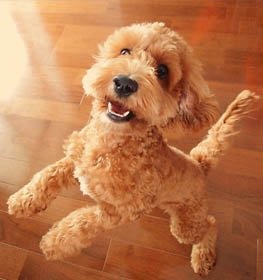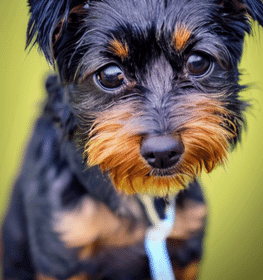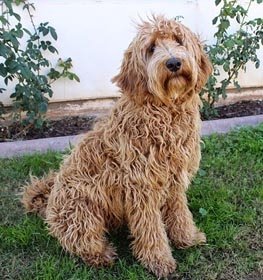Old Anglican Bulldogge Information & Dog Breed Facts
Collection of all the general dog breed info about Old Anglican Bulldogge so you can get to know the breed more.
| Group | Designer Dogs |
|---|---|
| Popularity Rank | 1718 |
| Reviews | 0 |
| User Ratings | |
|
Compare the Old Anglican Bulldogge With Other Dogs
Select at least one dog breed to make the comparsion. | |
 | |
| Origin | |
|
Breed Classification
What type of dog breed is an Old Anglican Bulldogge? Learn about its genetic classification and breeding category. | Cross Breed American Staffordshire Terrier and Bulldog mix |
|---|
|
Size Classification
What size category is an Old Anglican Bulldogge? Learn how big the Old Anglican Bulldogge breed typically grows. | Medium |
|---|---|
|
Weight Statistics
How much does an Old Anglican Bulldogge weigh? Discover typical weight ranges for adult males and females of the Old Anglican Bulldogge breed. | 57-67 pounds (25-30 kg) |
|
Average Weight
What is the average weight of an Old Anglican Bulldogge? | 62 pounds (27.5 kg) |
|
Height
How tall is the Old Anglican Bulldogge? Old Anglican Bulldogge height: | Male: 17-19 inches (43-48 cm), Female: 16-18 inches (41-46 cm) |
|
Average Height
What is the average height of an Old Anglican Bulldogge? | Male: 18 inches (45.5 cm), Female: 17 inches (43.5 cm) |
|
Price Range
How much does an Old Anglican Bulldogge puppy cost? Find current market prices and factors affecting Old Anglican Bulldogge costs. | $800-$1000 If you choose to purchase the Old Anglican Bulldogge, you should know that the mentioned amount of money is an average of the collected data from breeders’ sites and puppy finder places. If you have a Old Anglican Bulldogge for sale, please advertise it on a reliable website to make sure the Old Anglican Bulldogge gets to a happy place. |
|---|---|
|
Availability
How easy is it to get a Old Anglican Bulldogge? How many Old Anglican Bulldogge are there in the world? | Very frequent: The Old Anglican Bulldogge is quite easy to get. There is a risk of overbreeding, as it is an extremely popular breed. Inbreeding is common because of its popularity. A new study suggests that inbreeding contributes to the incidence of disease and health problems. So be careful, buy from a trustworthy place or kennel and seek the help of an experienced person, a professional, to make the right decision. |
|
Intelligence Rating
How intelligent is an Old Anglican Bulldogge? Discover the Old Anglican Bulldogge's intelligence ranking and learning capabilities. | Average: It takes patience to teach this breed any tricks or commands, but the effort is worth it. They understand and remember new commands after an average of 25-40 repetitions.
The Old Anglican Bulldogge ranks average in the intelligence ranking of dogs. |
|---|---|
|
Training Difficulty
How easy is it to train an Old Anglican Bulldogge? Learn about the Old Anglican Bulldogge's trainability and response to training methods. | Old Anglican Bulldogge dogs are quite easy to train. Sometimes they can be challenging, but if you're consistent in teaching new commands they will obey for sure. |
|
Watchdog Rating
How good is an Old Anglican Bulldogge as a watchdog? Learn about the Old Anglican Bulldogge's alertness and guarding instincts. | Old Anglican Bulldogge dogs are average watchdogs. If they sense something different, they will alert you, but observation isn't considered their main job.
|
|
Territorial Protection
Is an Old Anglican Bulldogge protective of its territory? Learn about the Old Anglican Bulldogge's guarding instincts and behavior. | Old Anglican Bulldogge dogs are average defenders. Some dogs are very protective of their territory, while others easily let a stranger to trespass. This breed is not sure to defend its territory in every situation. |
|
Personality Traits
What personality does an Old Anglican Bulldogge have? Learn about characteristic Old Anglican Bulldogge temperament and behavior traits. | LovingCourageousIntelligentFriendlyLoyalDevotedSocialSweetAggressiveAttentiveTenacious |
|---|---|
|
Sensitivity Level
How sensitive are they? Old Anglican Bulldogge sensitivity: | They are a little bit more sensitive than other dog breeds. Soft punishment affects them emotionally. Old Anglican Bulldogge dogs don't tolerate irregular daily routines, noisy households, and frequent guest visits really well.
They are receptive to their owner's emotions and make wonderful family companions. |
|
Affection Level
How affectionate are they? Is an Old Anglican Bulldogge a good family dog? | High: Old Anglican Bulldogge dogs are genuinely loyal, soft and gentle, loving, and affectionate dogs toward their handlers. They enjoy quality time with their owners despite the activity and are considered great therapy dogs for those in need. This breed responds strongly to their handler's emotions because they bond closely. Their happiness is your happiness. |
|
Social Needs
How much social interaction does the Old Anglican Bulldogge need? Old Anglican Bulldogge social needs: | Old Anglican Bulldogge dogs are a social breed. They enjoy being around people or other animals. This breed doesn't tolerate being left alone. |
|
Impulse to Wander or Roam
How likely is the Old Anglican Bulldogge to run away? Does this breed explore or wander a lot? Does Old Anglican Bulldogge roam? | Old Anglican Bulldogge dogs tend to escape less than other breeds. They have low to average wanderlust potential. Exploring the world is not the best activity they can imagine. |
|
Prey Drive
Do this canine have a strong prey drive? Does Old Anglican Bulldogge have high prey drive? | Old Anglican Bulldogge dogs have an average prey drive, which means that they don't have a high impulse to chase and catch something like a cat or any other small aminals, but it might happen. Training can help to achieve good behavior. |
|
Barking Frequency
Does an Old Anglican Bulldogge bark a lot? Learn about typical Old Anglican Bulldogge vocalization patterns and triggers. | Low to Average: The Old Anglican Bulldogge rarely barks. This breed could be a good choice if you're looking for a quiet breed. They don't bark unless there is a good reason.
Top reasons for barking: protection, alarm, fear, boredom, attention-seeking, greeting, separation anxiety, compulsive barking. |
|---|---|
|
Playful Nature
How playful is an Old Anglican Bulldogge? Understand the typical play drive and energy level of the Old Anglican Bulldogge breed. | Average: Old Anglican Bulldogges, like any other dog breed, like playing. Sometimes they bark in excitement for playing, but they are not the most playful dog breed. |
|
Apartment Adaptability
Can an Old Anglican Bulldogge live in an apartment? Learn about the Old Anglican Bulldogge's suitability for apartment living. | Apartment-friendly dog the Old Anglican Bulldogge breed. It is best if you have a small garden where it can occasionally go out to do its business, but this is not important at all. You can exercise him enough with a walk or two a day, so he's comfortable in an apartment. |
|
Lifestyle Adaptability
How adaptable is an Old Anglican Bulldogge to lifestyle changes? Learn about the Old Anglican Bulldogge's flexibility to new situations. | Old Anglican Bulldogge dogs adapt well to lifestyle changes and different living environments. They don't mind moving from one place to another with their owner. |
|---|---|
|
Alone Time Tolerance
Can an Old Anglican Bulldogge be left alone? Learn about the Old Anglican Bulldogge's tolerance to solitude. | Old Anglican Bulldogge dogs do best when a family member is at home during the day or if their workplace is dog-friendly so they can take the dog at work. |
|
Bite Risk Assessment
What is an Old Anglican Bulldogge biting potential? Learn about the Old Anglican Bulldogge's bite risk factors. | Low 🔽 The Old Anglican Bulldogge has a low chance of biting somebody. Top reasons for dog bite: protection, pain, excitement, herding instinct, being provoked. (Data based on the available online bite statistics.) |
|---|---|
|
Mouthing Tendency
Is an Old Anglican Bulldogge mouthy? Learn about the Old Anglican Bulldogge's tendency to use mouth during play. | Old Anglican Bulldogge dogs have a higher than average tendency to nip, chew, playbite, or herd people. It's a common habit during puppyhood, not aggressive behavior. These "bites" don't hurt, but Old Anglican Bulldogge dogs need to be taught a good attitude. |
|
Bite Strength Rating
How strong is an Old Anglican Bulldogge bite? Learn about the Old Anglican Bulldogge's bite force measured in PSI. | Between 200 and 400 PSI ⏺ Old Anglican Bulldogge bite force: Ordinary. Bite force Old Anglican Bulldogge measurements typically fall within the range of 200 to 400 PSI. The bite force of an Old Anglican Bulldogge is considered ordinary when compared to other dog breeds, but it is still quite powerful. This Old Anglican Bulldogge bite force PSI can cause bite wounds. Old Anglican Bulldogge bite PSI is not something that should be feared if the dog is well-trained and managed. To avoid any issues, it's essential to learn how to train an Old Anglican Bulldogge puppy not to bite from an early age.
The Old Anglican Bulldogge, and many others, have a fearsome presence because they have significant jaw strength, so it is important not to anger the dog and have it around strangers until it is fully trained. However, they are usually quite calm and good companions, they work well in families and are easy to care for. In conclusion, while the Old Anglican Bulldogge bite force is certainly an interesting aspect of the breed, it is important not to let it overshadow the many other reasons why these dogs are so loved and respected. With proper training and socialization, an Old Anglican Bulldogge can be a loyal and protective companion for your family. |
|
Average Lifespan
How long does an Old Anglican Bulldogge live? Learn about the typical lifespan of the Old Anglican Bulldogge breed. | 12-14 years The average lifespan of Old Anglican Bulldogge: 13 years |
|---|---|
|
Climate Tolerance
How well does an Old Anglican Bulldogge handle different weather? Learn about the Old Anglican Bulldogge's climate adaptability. | Prefers average to warm weather conditions Different dogs have different preferences when it comes to weather conditions. However, in general, most dogs prefer average to warm weather conditions, as they typically find hot weather conditions to be uncomfortable and taxing. |
|
Health Concerns
What health issues are common in an Old Anglican Bulldogge? Discover typical conditions affecting the Old Anglican Bulldogge breed. | Old Anglican Bulldogges are commonly healthy dogs. Vet costs aren't expensive with this breed. |
|
Vet Care Frequency
How often does an Old Anglican Bulldogge need vet visits? Learn about the Old Anglican Bulldogge's veterinary care requirements. | Rare The Old Anglican Bulldogge should have a complete physical check-up at least every 12-18 months (but preferably once per year). If your dog shows any symptoms, call your veterinarian. |
|
Health Problems
What genetic/health problems does the Old Anglican Bulldogge breed have? What are the health issues and concerns of the Old Anglican Bulldogge breed? Most common health risks of Old Anglican Bulldogge: | Hip Dysplasia Patellar LuxationEntropionCherry EyeDemodectic MangeReverse SneezingBrachycephalic SyndromeDry EyeHead Shakes |
|
Energy Rating
How energetic is an Old Anglican Bulldogge? Understand daily activity needs of the Old Anglican Bulldogge breed. | Old Anglican Bulldogge dogs have an average energy level, so if you live a semi-active life, this breed can be a good choice for you. |
|---|---|
|
Activity Requirement / Exercise Need
How much exercise does an Old Anglican Bulldogge need? How much exercise do Old Anglican Bulldogge dogs require per day?
Do Old Anglican Bulldogge dogs need a lot of exercises? | Old Anglican Bulldogge dogs have an average exercise need. This breed is satisfied with short walks every weekday and a long ones on weekends. |
|
Sleeping Need
How much sleep does the Old Anglican Bulldogge breed need? | Old Anglican Bulldogge dogs like sleeping so they do sleep a lot. They're not the most active dog breed. If you live an active life, this breed can be a bad choice for you. |
|
Obesity Tendency
Is an Old Anglican Bulldogge prone to weight gain? Learn about the Old Anglican Bulldogge's obesity risks. | Average to High: If you don't pay attention to the Old Anglican Bulldogge's weight, he can easily gain weight. More than one daily walk should be on schedule. To make your dog happy and fit, feed him with quality dry dog food and live an active life together. Try to find the happy medium between exercise and feeding.
If you notice any weight gain, consult your veterinarian and make a diet plan. Reduce unhealthy food and snacks, and measure the Old Anglican Bulldogge weight regularly. |
|---|---|
|
Food Consumption
How much food does an Old Anglican Bulldogge need daily? Learn about the Old Anglican Bulldogge's feeding requirements. | 2.5 to 3 cups of high-quality dry food a day, divided into two meals. |
|
Allergy Friendliness
Is an Old Anglican Bulldogge hypoallergenic? Learn about the Old Anglican Bulldogge's suitability for allergy sufferers. | No Old Anglican Bulldogge dogs don't do well with allergy sufferers by causing allergic reactions. Some dog breeds are even considered to higher possibility of an allergic response. Coat type isn't necessarily relevant, because most people are allergic to dander (flakes on the dog's skin) or saliva, not actually to dog hair. |
|---|---|
|
Coat Colors
What colors does an Old Anglican Bulldogge come in? Discover all possible Old Anglican Bulldogge color variations. | BlackGray Red Blue White BrownFawn Brindle |
|
Grooming Requirements
How much grooming does an Old Anglican Bulldogge need? Learn about Old Anglican Bulldogge coat maintenance requirements. | Easy to groom: The Old Anglican Bulldogge doesn't require a lot of grooming. Seasonal flea treatment is needed, but cutting the dog's hair by a professional groomer isn't necessary. Ears and eyes should be cleaned regularly to avoid infections. Old Anglican Bulldogge is a good choice if you don't have the time, skill, or money to take care of a high-maintenance dog. Recommended for beginners. |
|
Drooling Tendency
Does an Old Anglican Bulldogge drool a lot? Learn about the Old Anglican Bulldogge's drooling habits. | The Old Anglican Bulldogge drools quite a lot, so if you dislike being covered by slobber spots on your clothes, you may want to choose another dog breed. Drooling is the unintentional saliva flowing outside of the mouth. It can be completely normal or a sign of a health problem. Certain dog breeds drool more than others, just like the Old Anglican Bulldogge.
If you notice any change in your dog's drooling habit, you should contact a vet as soon as possible. |
|
Stinkiness Rating
Does an Old Anglican Bulldogge smell bad? Learn about the Old Anglican Bulldogge's natural odor levels. | Medium ⏺ The Old Anglican Bulldogge has an average chance of bad smell. Top reasons for dog stinkiness: infection of bad tooth/ear/skin folds, gas attacks. |
|
Coat Characteristics
What type of coat does an Old Anglican Bulldogge have? Learn about the Old Anglican Bulldogge's fur characteristics. | Fine |
|
Bathing Needs
How often does an Old Anglican Bulldogge need baths? Learn about the Old Anglican Bulldogge's bathing requirements. | 3-4 weeks More often than average. These dog coats tend to be longer, softer, and oilier than short-haired breeds. While a good bath every now and then is a great way to keep your buddy from becoming overly smelly, be mindful about overbathing.
Bathing will wash away your dog’s natural oils, while a simple brushing every few days should keep them clean. |
|
Shedding Level
How much do Old Anglican Bulldogge dogs shed? How to control, reduce and prevent the shedding of the Old Anglican Bulldogge? Do Old Anglican Bulldogge dogs shed a lot? | Old Anglican Bulldogge dogs are low shedders. It's a natural process of the hair growth cycle. The amount and frequency of hair loss mostly depend on their health status and breed type. |
|
Child Compatibility
Is an Old Anglican Bulldogge good with children? Learn about the Old Anglican Bulldogge's behavior around kids of different ages. | Old Anglican Bulldogge dogs are very kid-friendly dogs. This breed enjoys being surrounded by children.
|
|---|---|
|
Pet Compatibility
How well does an Old Anglican Bulldogge get along with other pets? Discover the Old Anglican Bulldogge's compatibility with other animals. | Old Anglican Bulldogge dogs are generally with other pets. |
|
Stranger Friendly
Are they aggressive or friendly towards/with strangers? Old Anglican Bulldogge temperament with other people: | Old Anglican Bulldogge dogs are very stranger-friendly dogs. |
|
Cat Friendly
How well do Old Anglican Bulldogge dogs get along with cats? Are they good with kittens? What is this fido's temperament with cats? Can they be good with cats? Can the Old Anglican Bulldogge breed live with a cat? | Old Anglican Bulldogge dogs are average friendly towards cats. |
|
Dog Friendly
Is Old Anglican Bulldogge good with other dogs? Are they dog-friendly dogs? How well do Old Anglican Bulldogge dogs get along with other dogs? | Old Anglican Bulldogge dogs are average friendly towards other dogs. |
|
Good For First Time Owners
Is Old Anglican Bulldogge breed good for first-time owners? Do they make a good dog for novice owners? Is Old Anglican Bulldogge breed suitable for first-time owners? | Yes Old Anglican Bulldogge dogs are good for novice owners, due to their easy-going personality. |
|
Office Friendly
Are Old Anglican Bulldogge dogs good office canines? Do Old Anglican Bulldogge dogs make good office-friendly pets? Can they be office dogs? | No Old Anglican Bulldogge is not the best dog breed for office environment. |
|
Senior Citizens Friendly
Are they senior citizens friendly dogs? How well do Old Anglican Bulldogge dogs get along with the elderly people? What is the Old Anglican Bulldogge temperament with senior people? Are Old Anglican Bulldogge dogs good for elderly owners? | Old Anglican Bulldogges are one of the best breeds for elderly people. |
|
Service Dog Capability
Can an Old Anglican Bulldogge be a service dog? Learn about the Old Anglican Bulldogge's service work potential. | Yes This breed makes good as a service dog. A service dog is a term used in the USA to refer to any type of assistance dog specifically trained to help people who have disabilities, such as visual impairment, hearing impairments, mental disorders, seizures, mobility impairment, and diabetes. Service dogs are protected under the ADA (Americans with Disabilities Act).
Old Anglican Bulldogge breed is a good choice for service purposes. |
|---|---|
|
Therapy Work Suitability
Is an Old Anglican Bulldogge good as a therapy dog? Learn about the Old Anglican Bulldogge's therapy work aptitude. | Not really This breed is generally not used as a therapy dog. A therapy dog is a dog that might be trained to provide affection, comfort, and love to people in hospitals, retirement homes, nursing homes, schools, hospices, disaster areas, and people with anxiety disorders or autism.
Old Anglican Bulldogge is not the best breed for therapeutic purposes. |
|
Scent Detection Ability
Is an Old Anglican Bulldogge good at detection work? Learn about the Old Anglican Bulldogge's scenting abilities. | Not really They are not typically employed for this type of work, but there may be exceptional cases. A detection dog or sniffer dog is a dog that is trained to use its senses (mostly its smell) to detect substances such as explosives, illegal drugs, wildlife scat, currency, blood, and contraband electronics such as illicit mobile phones.
Old Anglican Bulldogge is not the best breed for detection purposes. |
|
Search & Rescue Potential
Can an Old Anglican Bulldogge do search and rescue? Learn about the Old Anglican Bulldogge's SAR capabilities. | Not really This dog breed is not typically used as a search and rescue dog. The use of dogs in search and rescue (SAR) is a valuable component in wilderness tracking, natural disasters, mass casualty events, and locating missing people.
The Old Anglican Bulldogge is not the best breed for SAR purposes. |
|
Maritime Work Ability
Is an Old Anglican Bulldogge good on boats? Learn about the Old Anglican Bulldogge's maritime capabilities. | Not really Old Anglican Bulldogge breed usually doesn't like being on a boat. Boat dogs were typically bred for their strength, stamina, and water resistance, as they were often required to perform tasks such as pulling in fishing nets, and jumping into the water to retrieve ropes or lines, or helping to move cargo. Sailor dog is a type of dog that was bred to accompany sailors on their voyages. They were typically used for three purposes: as a working dog, a watchdog, and as a companion. A boat dog is a term used to describe a type of dog that was traditionally bred and used as a working dog on boats. |
|
Draft Work Capability
Can an Old Anglican Bulldogge pull carts? Learn about the Old Anglican Bulldogge's drafting abilities. | Yes A drafting dog or draft dog is a dog bred and used for cart pulling. Dogs bred for this work have strong builds and qualities that are needed, strength and determination.
Old Anglican Bulldogge breed is a good choice for drafting purposes. |
|
Military Service Background
Was an Old Anglican Bulldogge used in military service? Learn about the Old Anglican Bulldogge's military history. | Not really In history, this breed was not really used for combat dog. |
|
Puppy Litter Size
How many puppies does an Old Anglican Bulldogge usually have? Learn about typical litter sizes. | 5-10 puppies |
|---|---|
|
Pregnancy Duration
How long is an Old Anglican Bulldogge pregnant? Learn about the Old Anglican Bulldogge's gestation period. | 60-64 days Reproductive cycle of the female Old Anglican Bulldogge: The first period called Proestrus lasts for about 9 days.
During this time the females start to attract males. You can notice by swelling vulva and bloody discharge. The second part is the Estrus when the female is receptive for the male. It lasts for about 3 to 11 days. The sign of the proestrus part is the soft and enlarged vulva. The discharge decreases and lightens in color. The third part is the Diestrus. Normally, it occurs around day 14. In this period the female’s discharge changes for vivid red and coming to its end. The vulva returns to average, and she will no longer permit mating. The fourth part called the Anestrus. The time frame between heat periods normally lasts about six months. |
|
Breeding Frequency
How often can an Old Anglican Bulldogge have puppies? Learn about safe breeding intervals. | Once a year. More frequent breeding is not healthy. It is very important not to buy a dog from a puppy mill, where the needs of the pups and their mothers are ignored. It's an inhumane high-volume dog breeding facility, where puppies born several times a year. |
|
AKC Classification
What AKC group is an Old Anglican Bulldogge in? Learn about the Old Anglican Bulldogge's AKC classification. | Not recognized by the American Kennel Club. |
|---|---|
|
FCI Classification
What FCI group is an Old Anglican Bulldogge in? Learn about the Old Anglican Bulldogge's international classification. | Not recognized by FCI. |
Old Anglican Bulldogge Pros and Cons
- Health Concerns: Old Anglican Bulldogges are commonly healthy dogs.
- Apartment Adaptability: Apartment-friendly dog the Old Anglican Bulldogge breed.
- Grooming Requirements: Easy to groom: The Old Anglican Bulldogge doesn't require a lot of grooming.
- Shedding Level: Old Anglican Bulldogge dogs are low shedders.
- Impulse to Wander or Roam: Old Anglican Bulldogge dogs tend to escape less than other breeds.
- Lifestyle Adaptability: Old Anglican Bulldogge dogs adapt well to lifestyle changes and different living environments.
- Child Compatibility: Old Anglican Bulldogge dogs are very kid-friendly dogs.
- Senior Citizens Friendly: Old Anglican Bulldogges are one of the best breeds for elderly people.
- Good For First Time Owners: Old Anglican Bulldogge dogs are good for novice owners, due to their easy-going personality.
- Service Dog Capability: This breed makes good as a service dog.
- Draft Work Capability: A drafting dog or draft dog is a dog bred and used for cart pulling.
- Allergy Friendliness: Old Anglican Bulldogge dogs don't do well with allergy sufferers by causing allergic reactions.
- Drooling Tendency: The Old Anglican Bulldogge drools quite a lot, so if you dislike being covered by slobber spots on your clothes, you may want to choose another dog breed.
- Obesity Tendency: Average to High: If you don't pay attention to the Old Anglican Bulldogge's weight, he can easily gain weight.
- Mouthing Tendency: Old Anglican Bulldogge dogs have a higher than average tendency to nip, chew, playbite, or herd people.
- Alone Time Tolerance: Old Anglican Bulldogge dogs do best when a family member is at home during the day or if their workplace is dog-friendly so they can take the dog at work.
- Office Friendly: Old Anglican Bulldogge is not the best dog breed for office environment.




